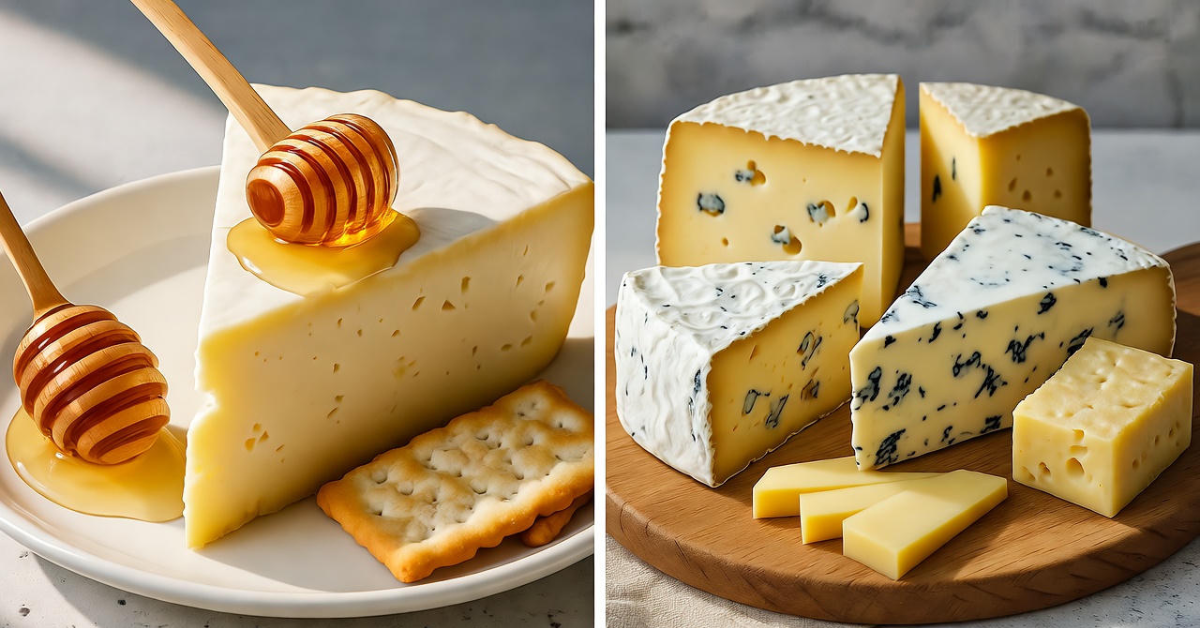Food & Drinks
Masgonzola Cheese: Creamy Italian Fusion Delight

Masgonzola is a soft, marbled cheese that blends sweet mascarpone with gentle Gorgonzola—perfect if you’re scared of strong blues. It’s a modern Italian treat, not an old classic, and it’s getting popular fast. You can spread it, melt it, or eat it straight—great on toast, in pasta, or even dessert.
Picture this: you’re at a party, staring at a cheese board. There’s a funky blue that smells like gym socks, and then there’s this creamy, swirled beauty that looks like vanilla ice cream with blue ribbons. Someone says, “Try the Masgonzola.” You take a bite. It’s rich, a little tangy, but not scary. You’re hooked.
What Is Masgonzola Cheese?
Defining the Marbled Fusion
Masgonzola isn’t just one cheese—it’s two best friends holding hands. About 70% mascarpone (that thick, sweet cream from tiramisu) and 30% Gorgonzola Dolce (the milder, younger blue cheese). A pale ivory spread with soft blue-green veins running through it. It’s soft enough to scoop with a spoon when fresh, but it firms up a bit as it sits. Think of it as the love child of dessert and dinner.
Origins and Italian Roots
This isn’t some 500-year-old recipe from a monk’s diary. Masgonzola started in the late 1990s in small dairies around Lombardy and Piedmont—places famous for both mascarpone and Gorgonzola. Cheesemakers wanted a blue cheese that wouldn’t scare people away. They layered the two cheeses by hand, let the blue mold do its thing, and boom—a new star was born. It’s not protected like true Gorgonzola (no DOP stamp), but that’s okay. It’s free to be creative.
Flavor and Texture Breakdown
Taste Profile Explained
First, you get the sweet, buttery hug of mascarpone. Then, a whisper of earthiness from the blue mold—like a hint of mushroom or wet stone. It’s only about 30% as intense as regular Gorgonzola. No sharp bite. No ammonia smell. Just balance.
How Texture Changes with Age
- Fresh (1–2 weeks): Silky, almost like thick yogurt. Perfect for spreading.
- Aged 30+ days: A little firmer, with sharper flavor pockets where the blue veins are thicker.
Pro tip: Let it sit out for 20 minutes before serving. Cold cheese hides flavor.
How Masgonzola Is Made
Step-by-Step Production
- Warm fresh cow’s milk and turn it into mascarpone—smooth and thick.
- Crumble in young Gorgonzola Dolce full of live blue mold.
- Fold them together by hand to create those pretty swirls.
- Wrap in cloth, brine lightly, and age in cool caves for 2 to 6 weeks.
It’s not rocket science—just patience and good milk.
Artisanal vs. Industrial
- Small-batch: Uneven veins, deeper flavor, shorter shelf life.
- Factory-made: Perfect marbling every time, lasts longer in your fridge.
Both taste great. Go artisanal if you can find it.
Masgonzola vs. Alternatives
Direct Comparisons
Here’s how Masgonzola stacks up against similar cheeses:
- Masgonzola: Mild, spreadable, $18–25/lb
- Gorgonzola Dolce: Creamier, crumbly, $14–20/lb
- Cambozola: Softer, more brie-like, $16–22/lb
- Plain Mascarpone: Sweet, no tang, $10–15/lb
If you want blue flavor without the punch, Masgonzola wins.
Vegan Substitutes
Yes, they exist! Some brands mix cashew cream with vegan blue culture. Taste is close—texture is softer. Great if dairy’s not your thing.
Culinary Uses and Recipes
Savory Applications
This cheese melts like a dream. Try these:
- Stir 2 tablespoons into hot risotto—creamy magic in 60 seconds.
- Stuff mushrooms with Masgonzola + prosciutto. Bake 15 minutes.
- Spread on flatbread with sliced pear and arugula. Done.
Sweet Pairings
Don’t sleep on dessert:
- Drizzle honey over a wedge and serve with walnuts.
- Swap half the mascarpone in tiramisu for Masgonzola—mind blown.
- Roll into dark chocolate truffles for a salty-sweet bite.
5-Minute Home Recipe
Want to DIY? Here’s the easiest hack:
- Take 200 g mascarpone (room temp).
- Crumble in 60 g Gorgonzola Dolce.
- Mix with a fork until marbled.
- Chill for 2 hours. Done.
Tastes 90% like the real thing. Your friends will think you’re a chef.
Nutrition and Health Facts
Per 1 oz (28 g) Serving
- 120 calories
- 11 g fat (7 g saturated)
- 6 g protein
- 0 g carbs
- 25% of your daily calcium
It’s keto-friendly and packed with probiotics from the blue mold—good for your gut.
Who Should Avoid It
- Anyone allergic to penicillin mold (rare, but real).
- People sensitive to histamine (can trigger headaches).
If lactose bothers you, you’re probably fine—fermentation eats most of it. Less than 1 g per ounce.
Buying and Storage Guide
Where to Source
It’s not in every grocery store yet. Try:
- Online: Murray’s Cheese or iGourmet ($22/lb + shipping)
- In-store: Whole Foods, specialty cheese shops, Italian markets
- Europe: Any good deli—€12–18 per kilo
Look for “Masgonzola” or “Mascarpone e Gorgonzola” on the label.
Storage Tips
- Wrap in wax paper, not plastic—let it breathe.
- Keeps 1–2 weeks in the fridge.
- Freeze up to 3 months (texture gets softer when thawed).
Smell test: if it smells like ammonia, toss it.
Sustainability and Ethics
Dairy Footprint
Making 1 kg of Masgonzola uses about 8 liters of milk, less than hard cheeses like Parmesan. Still, dairy isn’t light on the planet. Look for pasture-raised or grass-fed labels. Cows that roam produce milk with better fats and a lower carbon impact.
Emerging Trends 2025
- Almond-milk Masgonzola prototypes in Italy.
- Whey (leftover liquid) turned into ricotta—zero waste.
The future looks creamy and green.
Cultural Impact Beyond Food
Masgonzola as Metaphor
Weird but true—designers and writers love this cheese. One blog called it the “Masgonzola mindset”: blending soft and strong, sweet and sharp. Like balancing work and play. Or minimalism with bold color.
Real-World Case Study
In March 2025, a Milan cheese pop-up let 500 people taste six kinds of Masgonzola. 92% said it was their new favorite blue. One guy proposed to his girlfriend with a ring hidden in a honey-drizzled wedge. (She said yes.)
Conclusion
Masgonzola is more than just another cheese—it’s a creamy masterpiece that bridges the gap between bold and gentle flavors. Born in Italy’s dairy heartlands, it turns the strength of Gorgonzola and the sweetness of mascarpone into a perfect balance of taste and texture. Whether you spread it on toast, melt it into pasta, or pair it with honey and nuts, every bite feels indulgent yet comforting. As this marbled delight gains fame worldwide, one thing’s clear: Masgonzola isn’t just a cheese—it’s a delicious experience worth savoring.
